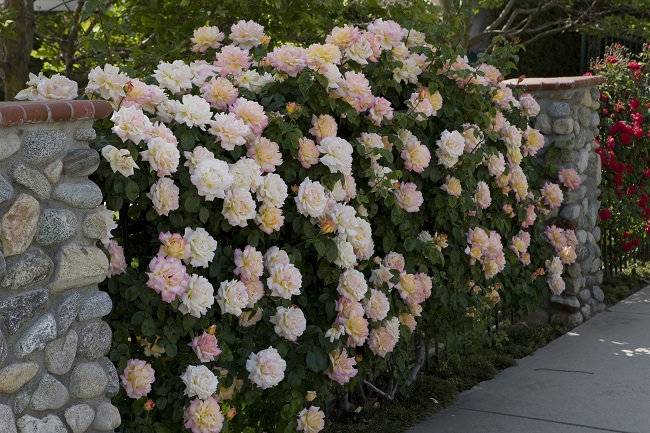May showers bring June roses or something like that. Warm climate gardeners are deadheading their first blooms to make way for the next delicious round of flowers, while rosarians in cold climates are watching the first buds peeking out from amidst the foliage.

Early spring can be a dangerous time for a rose garden, as the weather is often wet, the way rose diseases like it and the foliage is tender, the way aphids and caterpillars like it. And late frost can sneak up on the unwary, so be prepared to prune off any damaged foliage, blind shoots, or cane dieback.
A late frost, after the roses have started to grow, is not unusual where winters are cold. It can, however, damage the tender new foliage, usually at the top of the plants. If you can wash the frost off with a spray of water before the sun hits the plants, you can often prevent the damage. But if you get up as late as I do, the damage will have been done. Frosted leaves will wilt and begin to dry up. Prune off the damage as soon as it’s evident so new leaves and buds can begin to grow.
Cane dieback usually shows up within a few days after spring pruning. The pruning cut turns brown, and the necrosis may continue to spread down the cane. Cane dieback occurs when a fungal disease invades the green bark of the cane. Spray all parts of the plants with a good fungicide and prune off all the dieback. But this time make sure your pruner is clean and sharp. Pruner blades should be disinfected frequently with alcohol to prevent the spread of rose diseases. The blades should also be kept very sharp, so as not to shred the delicate bark on the cane. Shredded bark is a great place for fungal spores to flourish.
A blind shoot on a rosebush is not a normal situation. A new cane will always have a flower or cluster of flowers at the top and if you see a cane that doesn’t have a flower bud, you have a problem. If the plant is strong and healthy, has several old canes that are sprouting new secondary canes, and everything looks fine except one or more of the secondary canes just doesn’t have a bud at the top, you must assume that something has eaten your flower bud. An infestation of rose midge, caterpillars, or other bud-chomping bugs will likely get worse unless you move quickly to remedy the problem. Apply a good systemic insecticide to prevent further damage and prune the new cane back so another new cane, this one with a bud, will start to grow.
New basal canes, the ones that start to grow from the bud union or the crown of the plant, sprout most frequently in early spring and late summer. These canes are the future of your rosebush and should be allowed to grow until it’s time to deadhead the flowers at the top of the canes. You’ll first see new basal canes as their red foliage pokes out of the soil at the base of the plant. Healthy rosebushes sprout several new basal canes each season, and it’s always satisfying to know that your plant is happy.
There are times, however, when a new cane that sprouts from the base of a rosebush isn’t a good thing. This is when your rosebush is mostly or altogether dead. As you know, many rosebushes are propagated by budding, a form of grafting. The bud union, that woody knob where the plant was budded onto a hardy rootstock, is the most vulnerable part of the plant. In cold climates, the bud union can be damaged or killed if it’s not properly protected during winter. The rootstock, which is hardier than the original rose, may start to grow on its own.
Growing rootstock looks much different than a good rose cane does. It’s a thin, willowy cane with foliage that’s a lighter color green than good foliage. The leaflets will be spaced further apart along the length of the cane, and there will be no flower bud at the top. If you’re in doubt as to whether you have a good cane or a rootstock cane, sometimes called a sucker, follow the cane down into the soil to its origin. If it’s sprouting from the bud union, it’s a good cane, but if it’s coming from below the bud union, it’s a rootstock cane.
If your plant still has good canes and foliage, prune the sucker off at its origin and nurture the good part of the plant. If the rootstock cane or canes are the only ones the plant has sprouted, the plant is a weed, and you should dig it up and throw it away.
Chances are, though, your roses are healthy and happy and will soon be offering up their riches to reward your efforts. And there’s a whole summer full of roses to come!
Ann Hooper is a certified American Rose Society Consulting Rosarian.
Related Articles & Free Email Newsletter Sign Up
3 Ways to Figure Out the Correcting Plant Time for Roses
How to Recycle Old Items to Make Unique Planters for Your Plants
Struggling with Roses? Read the Directions and Try Again




Comment here